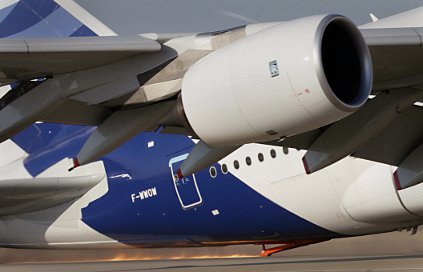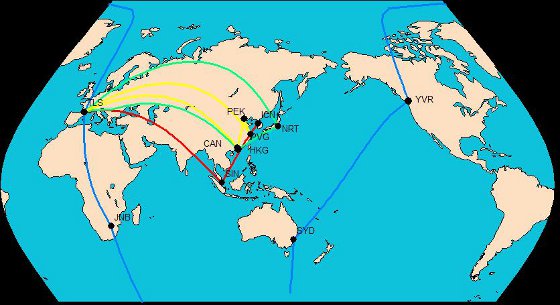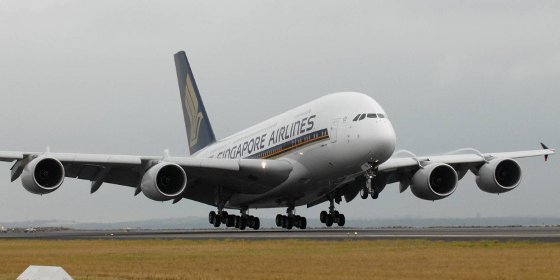| Issue 11 |
The speaker started by recalling that someone had told him that morning that his job must be what many children would dream of doing. Maybe he was a child at heart, but his toys had undoubtedly got bigger with the passing years! He then went on to describe what his flight-test department actually did. They are based at the Airbus Flight Test Centre at Toulouse, and for any given aircraft, their involvement begins many years before the first test flight, liaising with engineers of all disciplines about details of the design and in particular the cockpit integration. For him, the multi-disciplinary nature of the Oxford course had been an excellent background for this type of work where it is important to be able to work across all the systems required for aircraft development. A year before first flight a flight simulator is developed, as exact a match to the future aircraft as is possible at that stage, and also an "iron bird", which models all the hydraulic systems in parallel with the simulator.
In essence, developmental flight test will naturally lead to modifications, However, eventually the design is "frozen" for the certification process. These further flights lead up to the formal "Certification" of the aircraft at which point the aircraft can be used in commercial operations. However as well as these developmental tasks for the new aircraft, the department has continual pre-production test flights, often with co-pilots from potential customer airlines as well as demonstration flights for customers, politicians etc., and visits to air shows as well as the multitude of design meetings that are a continual aspect of the job. Plenty to do!
For the early test flights, the aircraft carries in the cockpit a pilot, a co-pilot and a test-flight engineer familiar with the modification status of the aircraft being flown. There is usually one, or perhaps two, flight test engineers in the back, monitoring systems and directing the flight test process. For the very first flight of the 380 there were also 70 engineers in the control room on the ground, studying flight safety critical data. However, as the telemetry bandwidth is limited, much more data is recorded on board to be analysed post-flight. The cabin at this stage looks nothing like what it will do eventually as a commercial airliner, being full of wiring, pipes, water tanks that can be loaded to simulate the weight of passengers and freight, and so on.
Airbus has had a policy of designing all its aircraft, from the A320 of 30 years ago, to have very similar cockpit interfaces, so that pilots find it reasonably simple to transfer from one type to another. This policy has been followed on the A380, although one exception is that the documentation that formerly had to be brought on board in brief-cases is now on computers.
An initial test flight is planned to be very "conservative" to start with, and if all goes well the aircraft is slowly pushed out towards the flight envelope limits. However, if anything unexpected happens, the test is abandoned until it has been investigated and the cause is fully understood. This cautious approach is carried right through any test program for obvious reasons. For first flight, all artificial "add-ons" to the dynamic behaviour, stability augmentation etc., are disconnected, so that the pilots can sense how the aircraft "really" responds to its controls. A "chase aircraft" also accompanies them on early flights, to observe what happens from outside, and to take photographs.
The plan for the A380 first flight, in April 2005, was to take off at 417 tonnes weight (as compared with 565 tonnes in normal service), and the centre of gravity in the middle of its permissible range. It would then climb to 10,000 ft, where undercarriage retraction, flaps etc. would be tested. Then up to 20,000 ft, increase the speed, see how the control response changes. Then try the air-brakes, get the chase aircraft to observe and visually check the airframe. Frequency-response tests were planned to see whether the aircraft was prone to aeroelastic structural oscillations, which can be very uncomfortable for passengers and crew at best and potentially very dangerous at worst. Thereafter, the plan was to try again at increased altitude and Mach Number.
In the event, it didn't go quite like this. They got to 10,000 ft and raised the landing gear. However a warning light remained on, indicating that an undercarriage door was not fully closed. The chase aircraft couldn't see anything wrong but it was considered imprudent to continue into the high speed range. After a few low speed tests the approach configuration handling was verified prior to return to base and landing. When the engines were switched off, and with them the hydraulic pumps, one landing-gear door slowly fell open, the up-lock not being correctly positioned!
With this simple fault corrected, further flights were made to expand the flight envelope, checking:
Test results were generally favourable and much as expected. Few aircraft modifications were required. They got as far as trying the automatic landing system on Flight 17, only 35 days after the first one, though it needed some 200 auto-land tests in total before it was fully approved for certification.
Stall and flutter characteristics had to be measured, and the optimum settings for flaps and slats determined. The wing lift coefficient is increased substantially for take-off and landing by flaps (on the trailing edge) and slats (on the leading edge) but the best angles at which to set them for performance reasons can only be found by a series of experiments, including the use of tufts or cones to visualise the airflow. In fact the wings were found to generate 3% more lift than the CFD programs had predicted, so landing and take-off speeds could be lower than originally anticipated.
That the aircraft could achieve its maximum design speeds was a fairly obvious requirement to be tested. More interesting however, was the measurement of VMU (minimum unstick speed), the lowest speed at which the aircraft could take off without hitting the aft end of its fuselage on the ground as it rotated for take-off. To protect the fuselage, a skid was fitted that would be abraded away (Figure 1). This could easily be replaced after a few such take-offs.

|
| Figure 1: Tail-skid in action |
Many of the test flights/runs involved verifying how the aircraft responded to various emergencies. For example, if one of the outer engines suddenly fails at full power during take-off, the aircraft is required not to deviate more than 10 m from its path down the centre of the runway (since running off the edge would be disastrous). The test has to be done at reducing speeds to minimise risk of runway excursion. The flight control system is designed to help limit this sideways motion by deploying a spoiler on the opposite side to the failed engine, which helps to balance the yawing moment and improve the weight distribution in order to reduce lateral displacement.
A similar limitation on lateral divergence is required when landing in cross-winds, of up to 52 knots. They had to do these tests in Iceland to find suitable conditions. If the aircraft is moving parallel to the runway in such a cross-wind before touch-down, then its longitudinal axis will be at a substantial angle to it. So when the wheels touch they will start carrying it to one side. This has then to be corrected before touchdown, by the use of rudder, and the ailerons too, to keep the wings level. A film of this enormous aircraft flying crabwise above the runway in such conditions had the audience gasping! In fact they recorded a maximum deviation of 5.4 m, which was quite acceptable. In fact the large inertia of the aircraft helps, because the lateral velocity lags well behind the yaw angle, so the A380 is easier to land in a cross-wind than any other Airbus model.
Landing on a water-logged runway was another challenge. It had to be verified (and was) that the resultant spray did not get into the engines.
Lightning and ice were other hazards whose effects had to be assessed. In fact the A380 turned out to be very robust in response to both lightning and to the turbulence which is also likely to be found in thunderstorms. The main effect of lightning is on the paintwork at the point where it strikes. Icing tests on the other hand are of two types. One can fly the aircraft in conditions such as cumulonimbus clouds where ice is likely to build up, and photograph the results. Or one can attach artificial "ice shapes" to the aircraft and see how they affect the performance, this time in smooth clear air so that the effects are not obscured by air turbulence. The ice-shape tests turned out to be the more demanding, but in neither case were there serious effects on the aircraft handling, but they did have to include a de-icing system on some of the wing slats to improve landing performance. It had been hoped that this would not be necessary in order to save weight.
The next task was to check that the aircraft was compatible with typical airports where it would have to operate, for instance that it matched standard boarding and loading equipment, and had a narrow enough turning circle for standard taxiways. This latter came to 55 m, about the same as a Boeing 777.
Then followed tests at airports where the temperature or altitude were abnormal. Medellin in Colombia is high up and hot. Iqaluit in Canada is very cold (-29 °C), and Al Ain in Abu Dhabi is very hot (up to 46 °C). The only serious issue found was in the cold-weather behaviour of the hydraulic systems and seals.
One of most spectacular tests was that to find whether the brakes could safely bring the aircraft to a standstill after an aborted take-off, with assistance from the air-brakes but none from the engine thrust-reversers. This treatment is expected to destroy the brakes and wheels, and it does, but it mustn't set the aircraft on fire. The test was to load the aircraft to 577 tonnes (above its maximum take-off weight), and then to bring it to a standstill from 167 knots. And the fire brigade is not allowed to do anything until five minutes after the aircraft stops! There are fusible plugs in the tires which deflate them before they get so hot that they burst. A film showed all this happening - smoke and flames coming out of the landing gear, but no damage to the aircraft otherwise.
They then had to check that the emergency chutes were capable of evacuating 853 passengers (from a very high-density cabin) and 20 crew in 90 seconds, in the dark, using only half of the available exits (the Certification requirement). The passengers for this test have to be a representative set, of all ages and sexes, not just fit 18-year-olds. A film showed 873 people getting down the chutes, on one side of the aircraft only, in 80 seconds, so the test was passed. This was in March 2006, less than a year after the first flight. There was one injury sadly, an elderly lady who broke her leg coming off the slide.
With this test complete, the aircraft could now be flown with passengers aboard. So lots of lucky people got free flights all over the world, including one right around it via both poles, in order to prove the aircraft as fit for purpose. It turned out that some minor adjustments were needed to the air-conditioning, but otherwise the passenger response was very positive - they found the cabin to be very calm, silent and spacious.

|
| Figure 2: Routes around the world |
Finally, the A380 could be fully certificated for airline use, which happened in December 2006, only 20 months after the first flight. Deliveries to airlines could now start, the first being to Singapore Airlines in October 2007.

|
| Figure 3: Singapore Airlines A380 |
| << Previous article | Contents | Next article >> |
| SOUE News Home |
Copyright © 2013 Society of Oxford University Engineers |
SOUE Home |